A few weeks ago, we looked at the advantage of using filter drains in combination with linear structures, but what if we want something a little greener?
This week we are will be taking a closer look at Swales, exploring how they can be used on developments, what we may need to look out for, before finally looking at ways you can enhance your swale.
The three types of swale
So, starting with the basics, what is a swale?
In simple terms, a swale is just a shallow, flat bottomed, vegetated open channel, which primarily is used for conveyance, but can also be used as part of your attenuation strategy by the incorporation of check dams or berms.
When it comes to design, there are three different types and which one you use depends on the type of site you are developing. The three different types of swales are:
- Conveyance and attenuation swales
- Dry swales
- Wet swales
A conveyance and attenuation swale acts similarly to a pipe in that it will collect and convey surface water to the next stage in the SuDS management train. They are usually shallow and contain some vegetation which means that they can be used for both attenuation and treatment. If soil conditions allow and they are left unlined they can also provide opportunities for infiltration.
Figure 1: Conveyance and attenuation swale
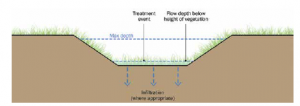
Source: CIRIA SuDS Manual
A dry swale is a vegetated channel underlain by an underdrain system, similar to a filter drain. In this approach, the swale collects and conveys the runoff with the filter medium providing the majority of the attenuation. This prevents the swale itself from becoming waterlogged and marshy.
Figure 2: Dry swale
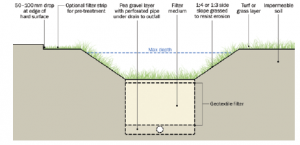
Source: CIRIA SuDS Manual
As you might expect a wet swale is the complete opposite, in that it is designed specifically to deliver wet and/or marshy conditions at its base. As the system is often saturated you will need to think carefully about the planting regime, using more water-compatible vegetation within the base of the swale. These systems are typically used at sites which are very flat or where the soils are poorly drained.
Figure 3: Wet Swale
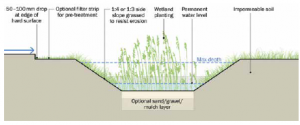
Source: CIRIA SuDS Manual
Whichever system you go for, the inclusion of planting provides opportunities to promote biodiversity and by integrating them into your landscape strategy they can help you to enhance the development and create spaces where people want to live and work.
Can they be used anywhere?
Swales are often used adjacent to linear structures such as roads, car parks and footpaths and can be incorporated into residential, commercial and industrial settings. They can easily be integrated into your landscape strategy and being towards the top of the SuDS hierarchy are excellent at removing urban pollutants and reducing runoff rates.
They work best on flatter sites as they are designed to slow the flow of water through the development. This means that they are less efficient on steeper sites although check dams or berms can be incorporated in some instances, but, in general terms, they should not be used where the gradient is greater than 10%.
Something else to consider is that the incorporation of swales on a development can also limit the opportunity for tree planting as the canopy can provide shade which can limit the growth of grass and other vegetation.
Finally, swales should be sited away from areas where roadside parking is likely as the vehicle could not only provide an obstruction to flow but it could also result in damage to the base of the swale which could lead to ponding and sediment build-up.
What maintenance might they require?
The great thing about the maintenance of a swale is that is generally not complex and can often be incorporated into your landscape management strategy.
Also, unlike a buried system, pollution and blockages are visible and as such, they can be easily dealt with before they become too much of an issue.
Regular maintenance includes things such as the removal of litter and debris from the surface, grass cutting and inspecting the inlets and outlets for silt accumulation.
Less frequent maintenance might be the alteration of the plant types in the system however, this is only really required if 10% of the swale treatment area becomes bare and more often than not it will be updates to the landscape requirements that will be the bigger driver.
Pimp my swale
In essence, swales are fairly simple in design and construction, however, that doesn’t mean there are not opportunities to enhance your swale if you so desire.
The easiest way to do this is through planting, however, there are a few other techniques which can be used to bring a bit of interest to your design.
As discussed previously, check dams are typically spaced at 10-20m intervals and are used to slow the flow further through your system and are particularly beneficial if there is a slight gradient on your site. They can be constructed of a variety of materials including coarse aggregate, gabions, concrete, rip rap or stone. Wood can also be used to create a more natural feel, however, it should be noted that a water-resistant tree species should be used such as cedar or swamp oak which will prevent the wood rotting and compromising your system.
Figure 4:Examples of Check Dams
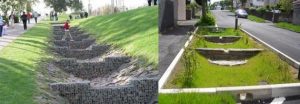
Source: Various
While water is generally directed into swales laterally, where they are used in series with interconnecting pipework there are opportunities to use specially designed inlets and outlets, such as the one below from Aco. In comparison to more traditional concrete headwalls, these can create a more natural feel on your development which complements the surrounding environment. They can also reduce the risk of erosion by up to a quarter compared to a standard pipe approach.
Figure 5:ACO Swale Inlet
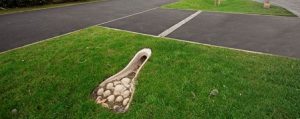
Source: https://www.aco.co.uk/products/suds-swale-inlet
Summary
In summary, swales can bring real benefits to your development, enhancing the space and creating new corridors for wildlife. They are relatively cheap to construct and maintain, can be used on a wide range of developments and you have the ability to make them as simple or complex as you like.
If you want to know more, why not check out the Susdrain website (https://www.susdrain.org/) which includes loads of information, resources and case studies or feel free to get in touch with us here at Rennard Consulting and let us explore how swales could be used on your development.